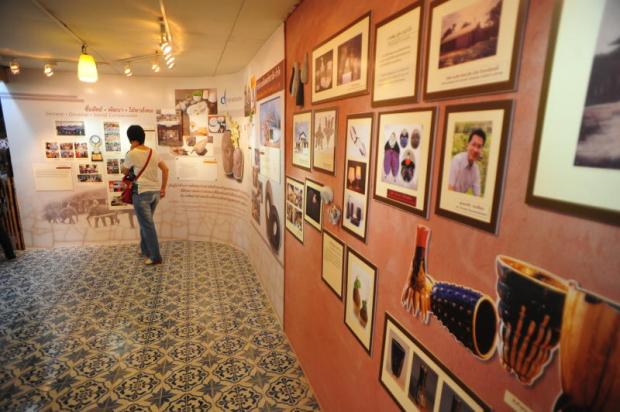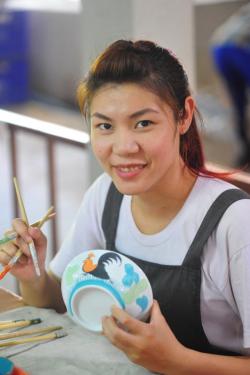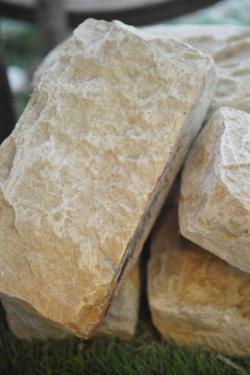The rooster bowl, a form of ceramic kitchenware once widely used in Thailand but for a time forgotten, still lives on in Lampang province.

A visitor enjoys the Dhanabadee Ceramic Museum.
In a pottery plant established 50 years ago, workers carry on in almost the same manner they would have back then. Clay is slowly shaped with very little help from moulds and machines as most of the processes, as they have been for decades, are still completed by hand.
"In the past, the bowl was hand-moulded and one worker would make 30 bowls a day. Today, with modern moulds, each worker can produce 300 rooster bowls a day," Saichon Yodkaew, a female staff worker at the factory, explains. The Dhanabadee Ceramic Group was once a major rooster bowl producer in Thailand. Its history dates back to 1955 when Chin Simyu, a Chinese immigrant in Thailand, found large deposits of kaolin in Lampang and decided to set up a ceramic factory there.

A painter decorates a rooster bowl.
Nearly a century ago, rooster bowls from China were highly prized by Chinese people in Thailand. Initially, they were cheap however the Sino-Japanese War caused a shortage in the rooster bowls which in turn caused their price to skyrocket. Some Chinese immigrants set up factories in Bangkok to produce the bowls. Nonetheless, supplies were somewhat limited due to insufficient supplies of kaolin, the main raw material needed to make the bowls.
Chin, who lived in Chiang Mai at that time, found whetstones carried by vendors and thought they contained deposits of kaolinite. He learned they came from Lampang. Then he tried hard to set up a ceramic factory there to produce the bowls. In 1979, Chin was honoured for discovering the quality resource of kaolin and for furthermore introducing ceramic to the province.
Today, the factory's business has developed far beyond traditional bowls. Most of its revenue comes from exporting ceramic arts and design products into overseas markets. However, its origins remain Lampang.
"We just want to keep the rooster bowl alive," Saichon admits.
The Dhanabadee Ceramic Group devotes part of its factory towards exhibiting the rooster bowl's distinguished characters, the story of its journey in Thailand and also the production process, from moulding and glazing in ash composites, to hand painting and firing.
Rooster bowls, cham gai in the Thai language or ge wan in Chinese, were an iconic piece of ceramic in the kitchens and on the dining tables of Thailand. Originating in South China over a century ago, the bowls can be easily noticed as they have a rather octagonal shape. Its most important characteristics are that of the painted rooster on one side of the bowl, a peony flower on the left, and a banana tree on the right.

Kaolin from deposits in Lampang.
The bowl is thick, durable and can be held with one hand, easily used for quick meals on the go. This is why the bowl was widely used among the working class and families in the countryside all those years ago.
When the Chinese migrated out of China, the bowls were exported to serve them. Rooster bowls can also be found in Hong Kong, Korea, Japan, Vietnam, Malaysia and Singapore.
"The rooster depicted on the bowl signifies hard work and a fighter spirit. The peony flower represents prosperity. The banana tree is a wish that tasks can be gotten through easily," Saichon says, explaining the meanings behind the representations on the bowl.
The museum displays rooster bowls from different origins. As they were hand-moulded and hand-painted by various factories, each bowl reveals small differences in sizes and patterns.
During the 1960s, the Thai government's nationalist policy encouraged Thai people to use domestic products. The campaign greatly fuelled the ceramic business in Lampang, particularly that of rooster bowl production. However, just a decade later, there were more players coming into the market. When imported goods began flooding into Thailand, Rooster bowls began to slowly disappear.
"Rooster bowls are burnt twice for durability. We used to sell it for 1.50 baht each at that time. But low quality ceramic bowls were available at 40 satang each. So it was hard to make ends meet. Finally we stopped mass production," Saichon explains.
The production of rooster bowls was resumed in 1997, after nearly three decades of suspension.
Today, just a handful of ceramic factories in Thailand remain, producing the old-fashioned bowls as souvenirs rather than as ordinary home utensils as in the market place or on dining room tables, the bowls have been replaced by modern style tableware.
Nonetheless, they have for collectors become rare items to show off. With regards to Chinese immigrants and Chinese descendants, the bowls still continue to reflect the spirit of hard work.

Cheap and durable, rooster bowls were once widely used in the kitchens of working-class families.

An old rooster bowl from the museum.

